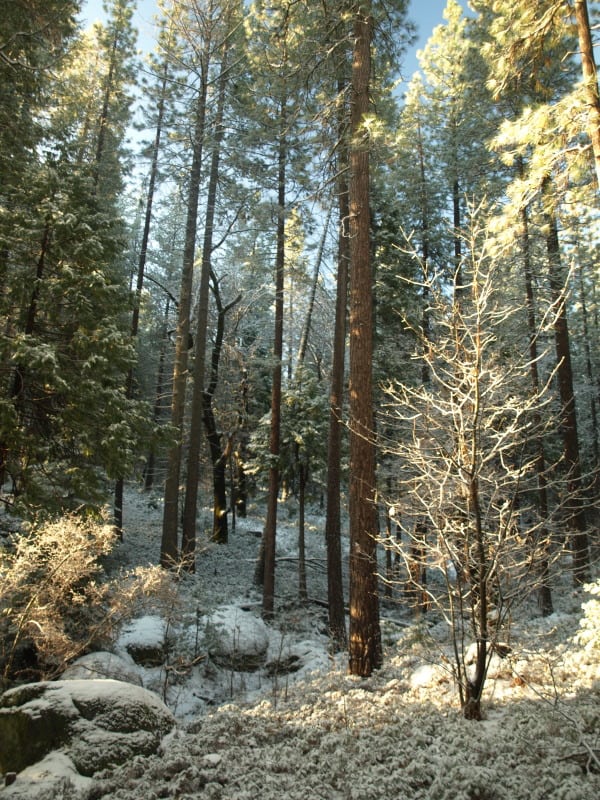(Below is a press release from the researchers. A copy of the study is available here. – mk)
New research shows that western dry forests were not uniform, open forests, as commonly thought, before widespread logging and grazing, but included both dense and open forests, as well as large high-intensity fires previously considered rare in these forests. The study used detailed analysis of records from land surveys, conducted in the late-1800s, to reconstruct forest structure over very large dry-forest landscapes, often dominated by ponderosa pine forests. The area analyzed included about 4.1 million acres on the Mogollon Plateau and Black Mesa in northern Arizona, in the Blue Mountains in northeastern Oregon, and in the Colorado Front Range.
The reconstructions, which are based on about 13,000 first-hand descriptions of forests from early land surveyors along section-lines, supplemented by data for about 28,000 trees, do not support the common idea that dry forests historically consisted of uniform park-like stands of large, old trees. Previous studies that found this were hampered by the limitations inherent in tree-ring reconstructions from small, isolated field plots that may be unrepresentative of larger landscapes.
“The land surveys provide us with an unprecedented spatially extensive and detailed view of these dry-forest landscapes before widespread alteration” said Dr. William Baker, a co-author of the study and a professor in the Program in Ecology at the University of Wyoming. “And, what we see from this is that these forests were highly variable, with dense areas, open areas, recently burned areas, young forests, and areas of old-growth forests, often in a complex mosaic.”
The study also does not support the idea that frequent low-intensity fires historically prevented high-intensity fires in dry forests.
“Moderate- and high-severity fires were much more common in ponderosa pine and other dry forests than previously believed ” said Mark Williams, senior author of the study and recent PhD graduate of the University of Wyoming’s Program in Ecology.
“While higher-severity fires have been documented in at least parts of the Front Range of Colorado, they were not believed to play a major role in the historical dynamics of southwestern dry forests .”
Some large modern wildfires, such as Arizona’s Rodeo-Chediski fire of 2002 and the Wallow fire of 2011 that have been commonly perceived as unnatural or catastrophic fires actually were similar to fires that occurred historically in these dry forests.
The findings suggest that national programs that seek to uniformly reduce the density of these forests and lower the intensity of fires will not restore these forests, but instead alter them further, with negative consequences for wildlife. Special-concern species whose habitat includes dense forest patches, such as spotted owls, or whose habitat includes recently burned forests, such as black-backed woodpeckers, are likely to be adversely affected by current fuel-reduction programs.
The findings of the study suggest that if the goal is to perpetuate native fish and wildlife in western dry forests, it is appropriate to restore and manage for variability in forest density and fire intensity, including areas of dense forests and high-intensity fire.
Key findings:
• Only 23-40% of the study areas fit the common idea that dry forests were open, park-like and composed of large trees.
• Frequent low-intensity fires did not prevent high-intensity fires, as 38-97% of the study landscapes had evidence of intense fires that killed trees over large areas of dry forests.
• The rate of higher-severity fires in dry forests over the past few decades is lower than that which occurred historically, regardless of fire suppression impacts.
The study was published online last week in the international scientific journal, Global Ecology and Biogeography. The published article can be accessed online here. The title is: Spatially extensive reconstructions show variable-severity fire and heterogeneous structure in historical western United States dry forests.
The authors are Dr. Mark A. Williams and Dr. William L. Baker, who are scientists in the Program in Ecology and Department of Geography at the University of Wyoming. Dr. Mark A. Williams is a 2010 PhD graduate, and Dr. William L. Baker is a professor, both in the Program in Ecology and Department of Geography. In Dr. Williams’s PhD, he developed and applied new scientific methods for reconstructing historical structure and fire across large land areas in dry western forests. Dr. Baker teaches and researches fire ecology and landscape ecology at the University of Wyoming and is author of a 2009 book on “Fire Ecology in Rocky Mountain Landscapes.”
Contact Information:
Dr. Mark A. Williams, Program in Ecology and Department of Geography, Dept. 3371, 1000 E. University Ave., University of Wyoming, Laramie, WY 82071. Email: [email protected].
Dr. William L. Baker, Program in Ecology and Department of Geography, Dept. 3371, 1000 E. University Ave., University of Wyoming, Laramie, WY 82071. Phone: 307-766- 2925, Email: [email protected].












